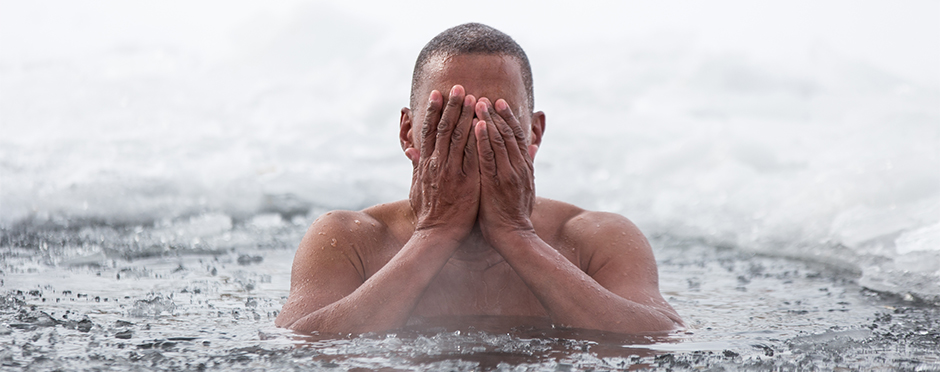
What is the Cold Plunge Trend?
Leave a CommentRecently seen all over various social media is the cold plunge trend. A cold plunge is where a person immerses themselves in cold or icy water for a certain length of time for various health benefits. The trend has sparked a lot of viewers to try this technique themselves, but we want to make sure you know the pros and cons and focus on performing this trend safely should you decide to try it out.
What is a cold plunge and how to perform
Cold plunging involves immersing oneself in cold or icy water for various lengths of time. Cold plunges can be performed in either indoor or outdoor tubs or pools or in specially designed tanks or barrels. Most people use water temperatures ranging from 38-60 degrees Fahrenheit, but some studies suggest a range from 50-59 degrees Fahrenheit is an optimal range1,2. This range is meant to focus on muscle soreness recovery1,2. Athletes and others have long used cold therapy to treat muscle soreness after a workout which may be how this trend started.
For those beginning cold water immersion, you should gradually ease in and begin with no more than 10-15 minutes. As you build tolerance, the length of time can be extended if desired.
Benefits
Cold water immersion has been studied most in terms of post-exercise recovery. Most of this research supports immersion shortly after an intense workout. In this manner, we are trying to treat potential inflammation due to exercise. Normally after exercise, one can expect some delayed onset muscle soreness (DOMs), but the use of cold water immersion may help with this muscle recovery and lead to less soreness3. However, other benefits reported include an overall reduced perception of pain and an improved sensation of well-being.
Due to the possible reduction in pain, people can use cold water plunges to treat short and long-term pain. People are using it as a means to treat inflammation without medications. The cold water may also slow down the speed with which your nerves send signals potentially decreasing the perception of pain2. Cold water may also help with improved circulation when paired with contrast water baths. Improved circulation can lead to increased oxygen levels in the muscle tissue, making your muscles and tissues healthier4.
Finally, cold water may offer a quick mood boost due to increased concentrations of dopamine found after immersion5. Dopamine improves our mental acuity and alertness as well as our overall mood.
Risks6
There is a risk of gasping or rapid breathing with cold water immersion due to the initial shock of it. This can be slightly reduced by entering the water more slowly than rapidly. An increased heart rate and an increase in blood pressure also occur with cold water immersion, increasing the risk of stroke or heart failure. If you have any cardiac, breathing, or blood pressure issues, check with your doctor prior to starting a cold plunge regimen.
The risks of cold water immersion also include hypothermia, which can increase the longer you stay in the water. It is recommended to start with shorter durations and gradually increase the length of time. Cold water plunges are not recommended for anyone with any peripheral vascular disease or those with current issues with decreased sensation or feeling in their arms or legs. The cold water will further those symptoms, and you may not be able to feel when it is time to get out.
Not a Trend for Everyone
Cold water plunges are trending, but that does not mean they are the right option for everyone. Please check with your doctor prior to starting a cold water immersion plan at home. An easier way to get some of the benefits of cold plunges with less risk is to turn your water to cold at the end of your shower for 10-20 seconds.
The Athletico blog is an educational resource written by Athletico employees. Athletico bloggers are licensed professionals who abide by the code of ethics outlined by their respective professional associations. The content published in blog posts represents the opinion of the individual author based on their expertise and experience. The content provided in this blog is for informational purposes only, does not constitute medical advice and should not be relied on for making personal health decisions.
References:
1. Bleakley C, McDonough S, Gardner E, Baxter GD, Hopkins JT, Davison GW. Cold-water immersion (cryotherapy) for preventing and treating muscle soreness after exercise. Cochrane Database Syst Rev. 2012 Feb 15;2012(2):CD008262. doi: 10.1002/14651858.CD008262.pub2. PMID: 22336838; PMCID: PMC6492480.
2. Machado AF, Ferreira PH, Micheletti JK, de Almeida AC, Lemes ÍR, Vanderlei FM, Netto Junior J, Pastre CM. Can Water Temperature and Immersion Time Influence the Effect of Cold Water Immersion on Muscle Soreness? A Systematic Review and Meta-Analysis. Sports Med. 2016 Apr;46(4):503-14. doi: 10.1007/s40279-015-0431-7. PMID: 26581833; PMCID: PMC4802003.
3. Allan, R., Malone, J., Alexander, J. et al. Cold for centuries: a brief history of cryotherapies to improve health, injury and post-exercise recovery. Eur J Appl Physiol 122, 1153–1162 (2022). https://doi.org/10.1007/s00421-022-04915-5
4. Shadgan B, Pakravan AH, Hoens A, Reid WD. Contrast Baths, Intramuscular Hemodynamics, and Oxygenation as Monitored by Near-Infrared Spectroscopy. J Athl Train. 2018 Aug;53(8):782-787. doi: 10.4085/1062-6050-127-17. Epub 2018 Sep 13. PMID: 30212235; PMCID: PMC6188085.
5. Šrámek, P., Šimečková, M., Janský, L. et al. Human physiological responses to immersion into water of different temperatures. Eur J Appl Physiol 81, 436–442 (2000). https://doi.org/10.1007/s004210050065
6. OSF HealthCare. Cold Plunging: Do the Benefits Outweigh the Risks?, OSF HealthCare, 20 Jan. 2023, https://newsroom.osfhealthcare.org/cold-plunging-do-the-benefits-outweigh-the-risks/#:~:text=Furthermore%2C%20the%20National%20Center%20for,of%20heart%20failure%20and%20stroke.</p>
